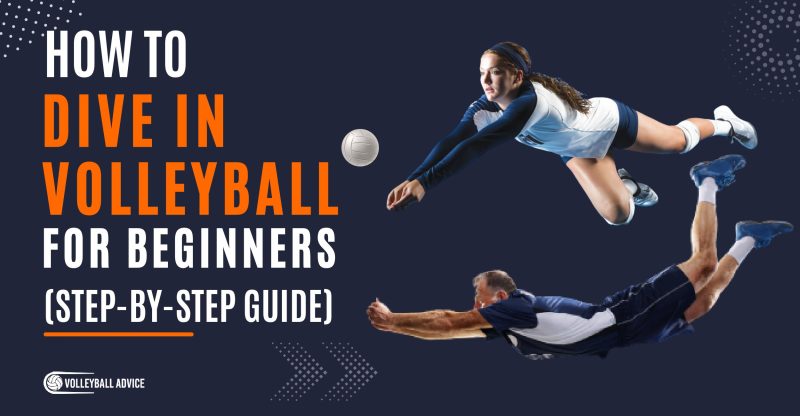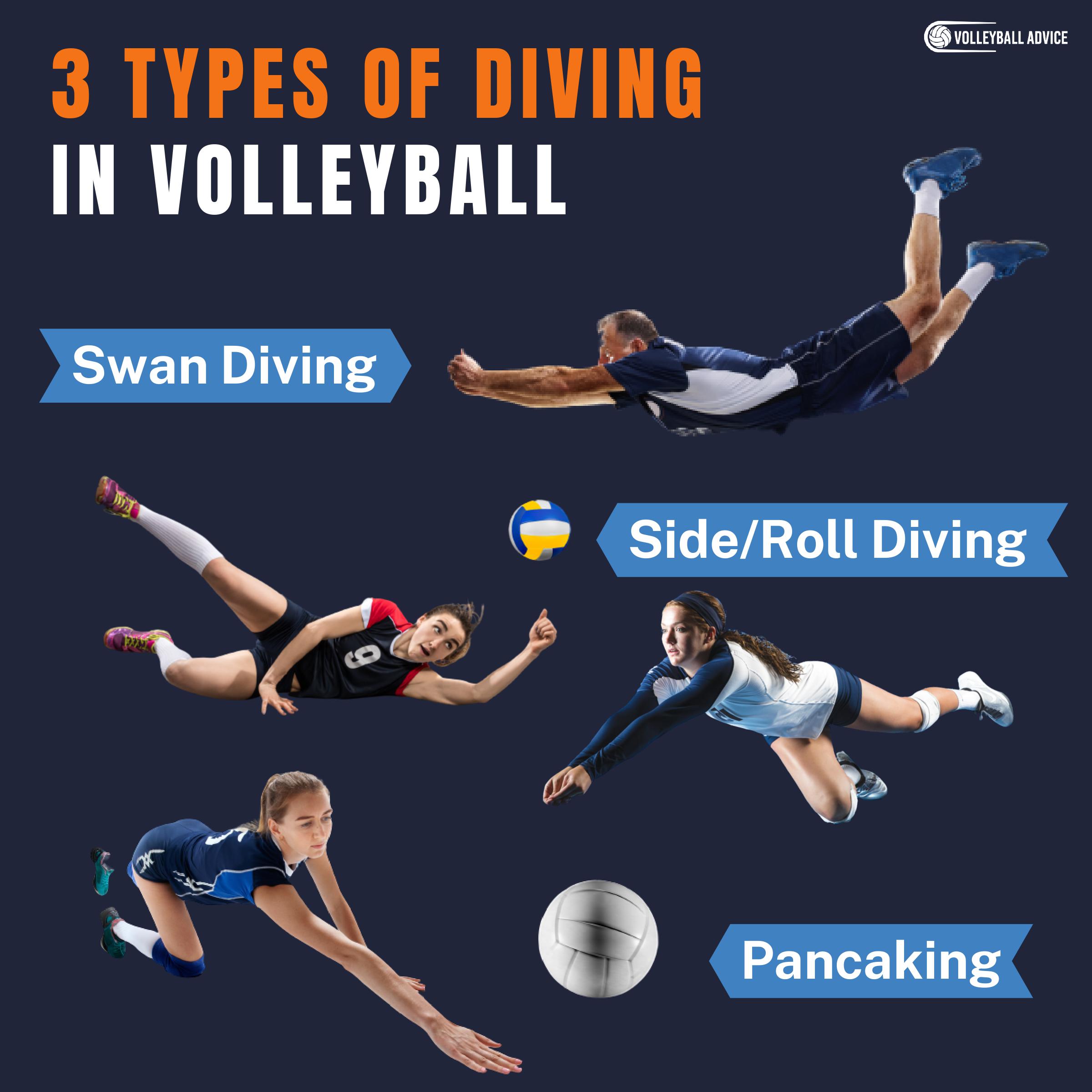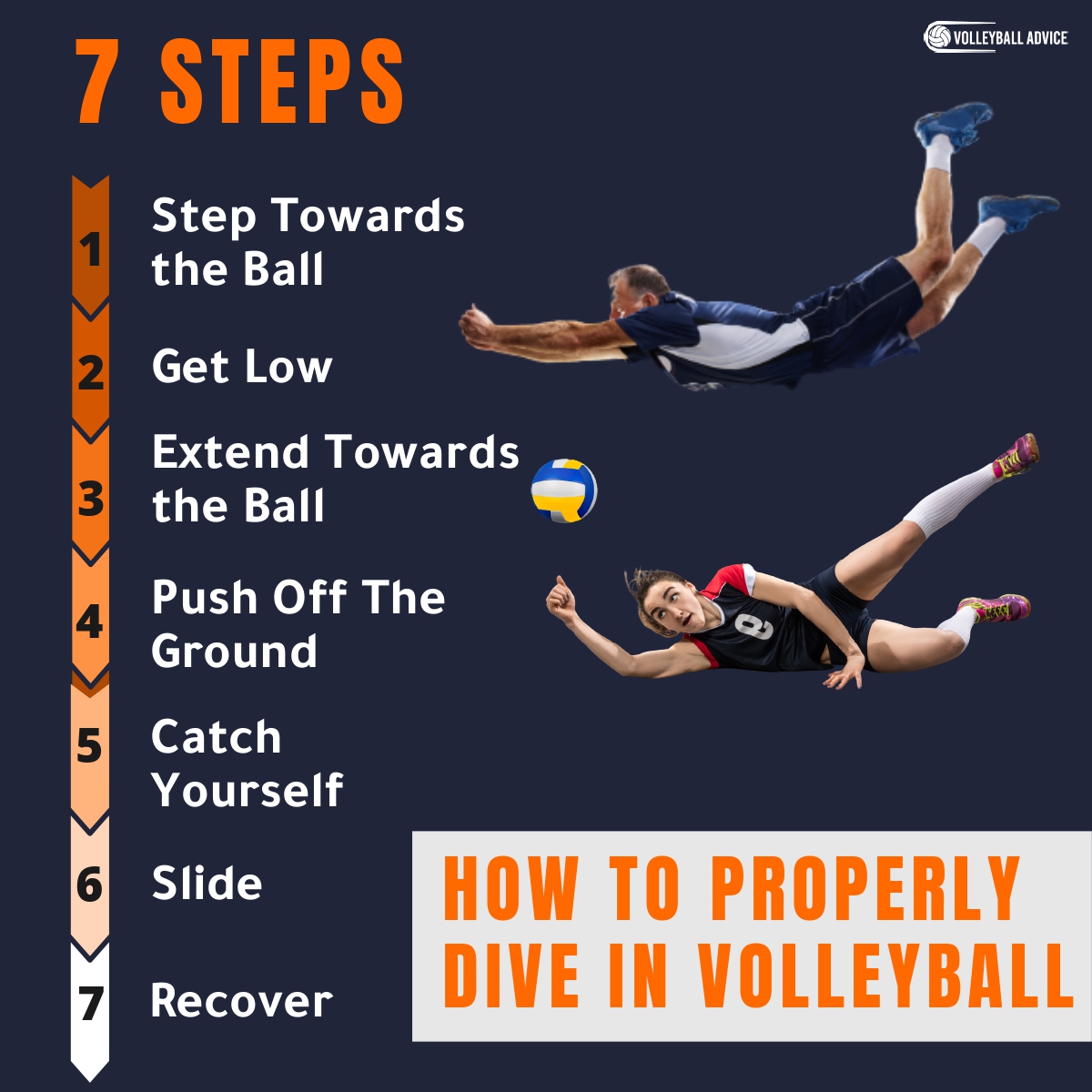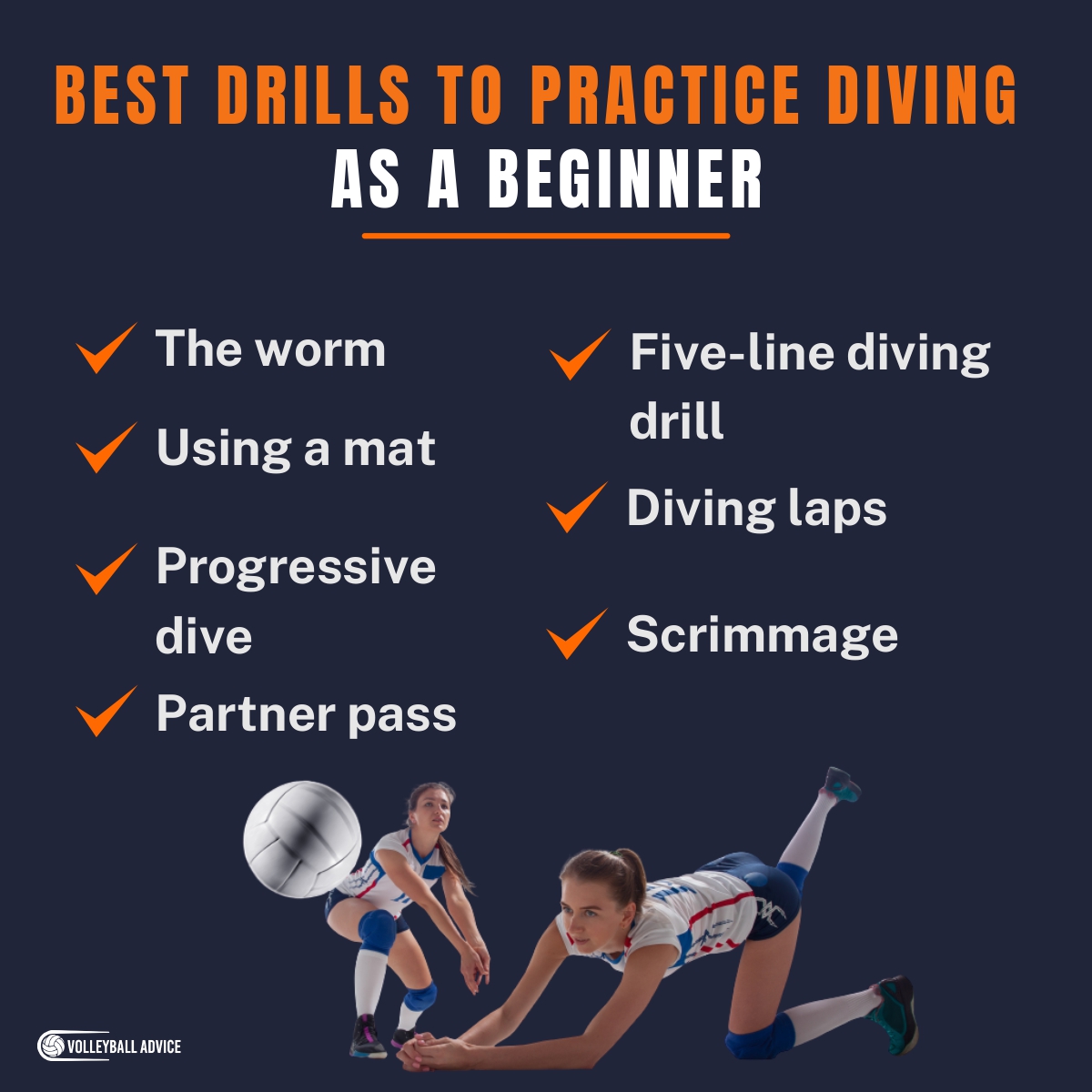How To Dive In Volleyball For Beginners (Step-by-Step Guide)
Diving is an essential skill for volleyball defenders, but can be difficult for beginners to learn due to its advanced nature.
There is a misconception that diving is “unsafe” or dangerous, but proper diving technique is both safe and comfortable to perform. For most players, the biggest challenge is not the technique in itself – it’s overcoming the mental barrier inside their head.
So, how do you dive in volleyball? To dive in volleyball, step towards the ball with your outside foot. Get low, allowing your body to sink towards the floor, coiling into a spring. Extend your arms and body towards the ball, falling outwards and down: this is the point where you pass the ball. Guide yourself to the ground with your hands and slide.
I’ll breakdown these steps further below so that any beginner will be able to quickly pick up the skill of diving.
While there are a few different types of dives in volleyball – the “swan dive” – is by far the most useful and first taught. Mastering this will help you learn the “side dive” (or “roll”) and even how to pancake (another type of diving).
By the end of this article, you should be able to:
- Understand the steps to diving and know how to practice them
- Know when a dive should be used
- Identify the symptoms of your mental block and face them
- Avoid injury through good technique
What Is A Volleyball Dive?
A dive in volleyball is a maneuver that allows a player to pass a ball that is usually too far out of reach to pass. It’s a quick reaction that throws your body parallel with the ground, and slides you safely after passing like an otter. It’s an essential tool for defense, and an invaluable asset to any player’s toolkit – especially liberos.
Long ago, players realized that if you’re passing low to the ground, you’re probably going to end up on the ground as well. Diving is amazing because it allow you to control how you get there – and how you get back up – while still playing the ball.
In short: diving gives players control over a seemingly chaotic movement, and turns it into a practical tool.
Types of Diving In Volleyball
There are three types of diving in volleyball:
- swan diving
- side/roll diving
- pancaking
As pancaking differs in teaching and is not for beginners, I will only be discussing the first two types in this article.
The difference between swan diving and side/roll diving is simple:
A player can swan dive for any ball too far out of reach, but is especially useful when chasing down a ball behind you or out of bounds. A side/roll dive is used specifically when the ball is falling outside the reach of you to either side, and doesn’t cover as much distance.
A swan dive looks graceful, like a swan landing on water or a cat chasing a mouse, or even an otter sliding into its pond. A side/roll dive looks more rough-and-tumble, with players appearing to collapse to one side and extend their arms along the floor to pass the ball. This is sometimes played with a rolling follow-up, where the player rolls around their arm and returns to their feet in one smooth motion.
Whichever style you prefer to use, both dives are very useful and can be played with at high levels.
When To Dive In Volleyball?
A dive is used in volleyball anytime the ball is dropping to the floor too far out of reach for a player to reach.
The only exception to this rule is when another player has called the ball as theirs. Even if it’s dropping right in front of them, if they haven’t called the ball and they don’t look like they’re going to pass it, dive for it! Being assertive is the best way to ensure that the volleyball never drops without a fight, and that’s why calling the ball is so important.
For any coaches reading this: if your players are having trouble communicating and calling the ball, run the rest of the practice as a silent practice. No one is allowed to speak for any reason, no music is allowed to be played, and anyone who breaks these rules runs a five-line diving drill (see the “drills” section of this article for my version of five-line). I guarantee they’ll hate it, and your players will quickly learn what a gift communication actually is.
Basically, if you see a ball dropping out of reach or out of bounds and you’re the closest player to it, it’s yours. You need to get that ball, and sometimes the only way you can do that is by diving.
You should also dive in volleyball to make falling more safe.
If you’re lunging for a ball and find yourself off-balance, the best option might be to commit to a dive instead of risk injuring yourself. Try not to dive into bleachers or the scoring table, because that’s the fastest road to injury and off the court.
How To Properly Dive In Volleyball (7 Steps)
Before we start, watch this video of some incredible dives to get you thinking about what diving should look like and how it’s used.
The 7 steps of diving in volleyball are:
- Step towards the ball
- Get low
- Extend towards the ball
- Push off the ground
- Catch yourself
- Slide
- Recover
Step 1: Step Towards the Ball
In volleyball, we’re always moving forward, even if that’s not directly towards the net! Always dive forward – never backwards – as that can lead to injury and bruised tailbones.
Step 2: Get Low
The purpose of getting low is to both maximize your reach and avoid injury. Aim to dive from below waist height, as diving from higher up is a more advanced skill and requires training.
Think of yourself as a spring and contract your body into a coil, like Tigger winding up for the whoop-de-dooper loop-de-looper ali-ooper bounce!
Step 3: Extend Towards the Ball
Extend your arms first, then your body towards the ball, falling outward and down. Because you are already low, your extension should be mostly sideways, parallel to the ground, leading directly to the next step. Remember: you MUST COMMIT to the dive for it to be safe and feel good.
Try to pass the ball during this stage. Either one arm or two arms is fine – I find one arm is better when chasing because you can get more height, but it’s entirely personal preference. I use the two armed receive when diving plenty too.
Step 4: Push Off The Ground
Do this as you become close to the ground, propelling yourself parallel to it. The purpose of this step is to avoid falling at the impractical angle that simply collapsing puts you at. This will let you slide on your chest or side rather than your hips.
Pass the ball now, if you have not done so already.
Step 5: Catch Yourself
Catch yourself with your hands and guide yourself to the ground.
The purpose here is not to support your body weight, but to control how it contacts the ground. You want to be moving forward still, and “swan” through it, pushing your hands to the side and back of your body as you land, like an otter.
Step 6: Slide
Time to slide! Keep your chin up to avoid injury and push your chest out to keep your limbs from catching – not doing this is what usually results in knee burns.
Allow yourself to coast until a stop, or stop your momentum with your hands if you need to turn around quickly. The harder you push off the ground, the farther you’ll slide, so be mindful of that when you’re diving!
Step 7: Recover
Return to your feet and the ready stance as quickly as possible. Remember, a good diver doesn’t stay on the floor.
How Do You Overcome Mental Block With Diving?
Mental block is the condition where a player freezes or cannot perform a certain action because of fear or anxiety. It’s not something to downplay – it can be paralyzing – and it’s a bit hurdle to overcome for new players of any sport.
Focus on Something Small, Rather than the Action Itself, like Taking That First Step
Often, that first step is the key to unlocking your whole movement. Build from there, step by step, until you are successful.
Practice Will Help a Lot
Stick with mats if you have them until you’re feeling comfortable, or progress from low, sitting stages before moving to the standing dive.
Try not to practice on tiles at home, and find wooden floors like a volleyball court. Sand or grass work surprisingly well too, or snow if it’s the right season for it.
You Need to Want It Bad Enough
You have to believe in yourself, and trust yourself as a player to do it properly.
You need to want the ball more than you fear getting hurt. You need to want to win more than anything, and that will let you do anything, be anything, to achieve that. I know it’s tough, I’m not saying it’s not.
Believe You Can Do It & Be Patient
Mental block is huge, and it’s hard for everyone. Just be patient with yourself and understand that you won’t become instantly amazing.
Keep practicing and being mindful, and one day it will just happen. You’ll start diving, and wonder how you did it.
Common Mistakes When Learning How To Dive In Volleyball
1. Diving on Your Chin
This is caused by tucking your chin in when you dive and will scar you forever. Look at volleyball players’ chins and you’ll see a lot more of these scars than you think.
2. Not Pushing off the Ground/Jumping Up
Please don’t jump up when diving, ever. You’re only adding more height before you come crashing down, which will be much more painful and drive the wind out of you. Not to mention it’s less efficient and wastes momentum better used sideways.
3. Landing with Weight on Arms
Again, a major injury risk from the incorrect technique. While you use your hands to guide your body to the ground, they don’t actually support your weight when diving, and you don’t land on them. This can cause sprains and jammed fingers, neither of which make us feel good about diving again in the future.
4. Landing on Knees
Don’t land on your knees as it will leave you with the most scrapes and cuts over your diving career. Push your chest out and slide along it when you dive, and your knees shouldn’t contact the floor.
5. Trying to Pass After Landing
Usually – unless pancaking – the pass happens before you land from your dive. This is in order to free your body and mind for landing, but also because it gives you more control the sooner you contact it. Playing off of the floor really only gives one direction possible, and not always the most useful: up.
6. Just Falling/Throwing Yourself at the Ball
Dangerous to yourself and hazardous to those around you. Please don’t do this ever.
How Do You Practice Diving? (Tips and Drills)
There are a lot of interesting drills and tricks you can practice to help improve your diving technique and to get you comfortable with contacting the floor. They range from pretty goofy moves to some serious diving concentration, so choose the option that’s right for you.
Here are the best drills to practice diving as a beginner:
- The worm
- Using a mat
- Progressive dive
- Partner pass
- Five-line diving drill
- Diving laps
- Scrimmage
The Worm
Everyone knows the worm, but if you don’t I’ve linked a tutorial down above. This may seem goofy at first – and it is – but it also can help players overcome mental blocks and have some laughs while getting acquainted with how their body is supposed to move on the floor.
The movement in the worm helps inform players’ bodies how to contact the floor safely without hurting themselves, and how to roll onto/off of it if need be. We use many of these motions in adapted ways while diving, so it is an excellent warm-up for beginners learning to dive.
Using a Mat
There’s nothing wrong at all with using a mat to learn safely and to build confidence – In fact, I recommend it. This will help protect you in the early stages.
Progressive Dive
A progressive dive is a dive where you begin from the preceding step and practice the next step with repetition or to alter the dive to be less intimidating. The purpose here is to build confidence rather than technique, although it can be used from that too.
One example of this is diving from the knees instead of standing. The progression from here is to one leg, then a crouched position, then ready position or “standing” (you should always be in your ready position when idle in volleyball anyway. Start near the ball, then get farther as you become comfortable.
Partner Pass
Very simple: practice with a partner and have them toss a ball just out of reach. This will force you to dive. Work in sets of five and switch.
Five-line diving drill
Often used as a punishment drill by coaches, this is one of the fastest ways to improve your diving through self-practice.
A normal five-line drill (commonly referred to as players of many other sports – like tennis – as a “suicide”) involves players running from the baseline to the first line, touching it, and sprinting back to the baseline. This is repeated only to the next time, then again to the next, and so on.
For the diving variant, dive to touch the line and get up as fast as you can.
Diving laps
Similar to the five-line drill, this can also be used as a punishment drill but I’ve found is a nice warm-up and cool down after practice. All it involves is moving around the exterior of the court in a lap, moving only with dives and diving footwork.
Make it a habit to do at least one lap before and after practice, and you’ll see your diving improve exponentially in as little as a week.
Scrimmage
There’s no substitute for the real thing, and that means game time. It’s also the most fun.
For this exercise, elect to play defense or libero, even if it isn’t your role. Every player should practice playing every position at least once, so this is a good exercise anyway. The purpose of playing defense here is because they get the most out-of-reach balls to pick up, so will allow you more opportunities to go for them.
Try to play this position at least once a week, and keep score of how many balls you successfully touch and how many you pick up. Keep a running count, and watch yourself improve. For liberos, keep this journal every practice, and look back through it when you need motivation.
Frequently Asked Questions:
How Many Steps Is A Volleyball Dive?
As many as needed to reach the ball. My footwork includes only one before going into your extension and slide. This makes it easy to perform and keep track of in players head, as opposed to two or three step footwork which needs some planning ahead of when it’s performed and a mental estimation of the space required.
How Do You Get Comfortable In Volleyball Diving?
The best way to get comfortable in volleyball diving is to practice. Make the floor your friend get in the habit of diving. Do this often by practicing drills and diving laps, or just playing with friends. Dive for balls you don’t need to. Push yourself to dive for balls you cannot get. Eventually, you will be as comfortable diving as walking.
How Do You Dive In Volleyball Without Hurting Your Hips?
Damage from diving can be largely negated by good technique, but the hips are often the ones most hurt. The best way to avoid this, however, is to slide on your chest rather than your side. Have your shirt tucked in and aim to slide horizontal to the ground, not falling directly on it from above.
Equipment For Diving
I’ve tested several knee pads and sleeves over the years that help protect your knees while diving. You can read more about my reviews of these products here:
Other Video Resources
Helpful diving video (Coach Donny):
Information about side/roll diving and how the University of South Florida athletes perform it:
Related Articles
- Types of Sets In Volleyball: 18 Types Explained + How To Use
- 10 Types of Serves In Volleyball (Detailed Breakdown)
- 16 Types of Spiking in Volleyball (Helpful Visuals)
About The Author
Ailan Samuel is a writer and athlete who has played volleyball at the university, club, and national level since 2012. He has competed successfully in both beach and indoor competitions, resulting in four silver and two gold medals, and was awarded the Half-Blue while playing in Scotland. He received his MA in English and Medieval History from the University of St Andrews, Scotland, and is currently studying for his MA in Publishing and Creative Writing at Bournemouth University.





